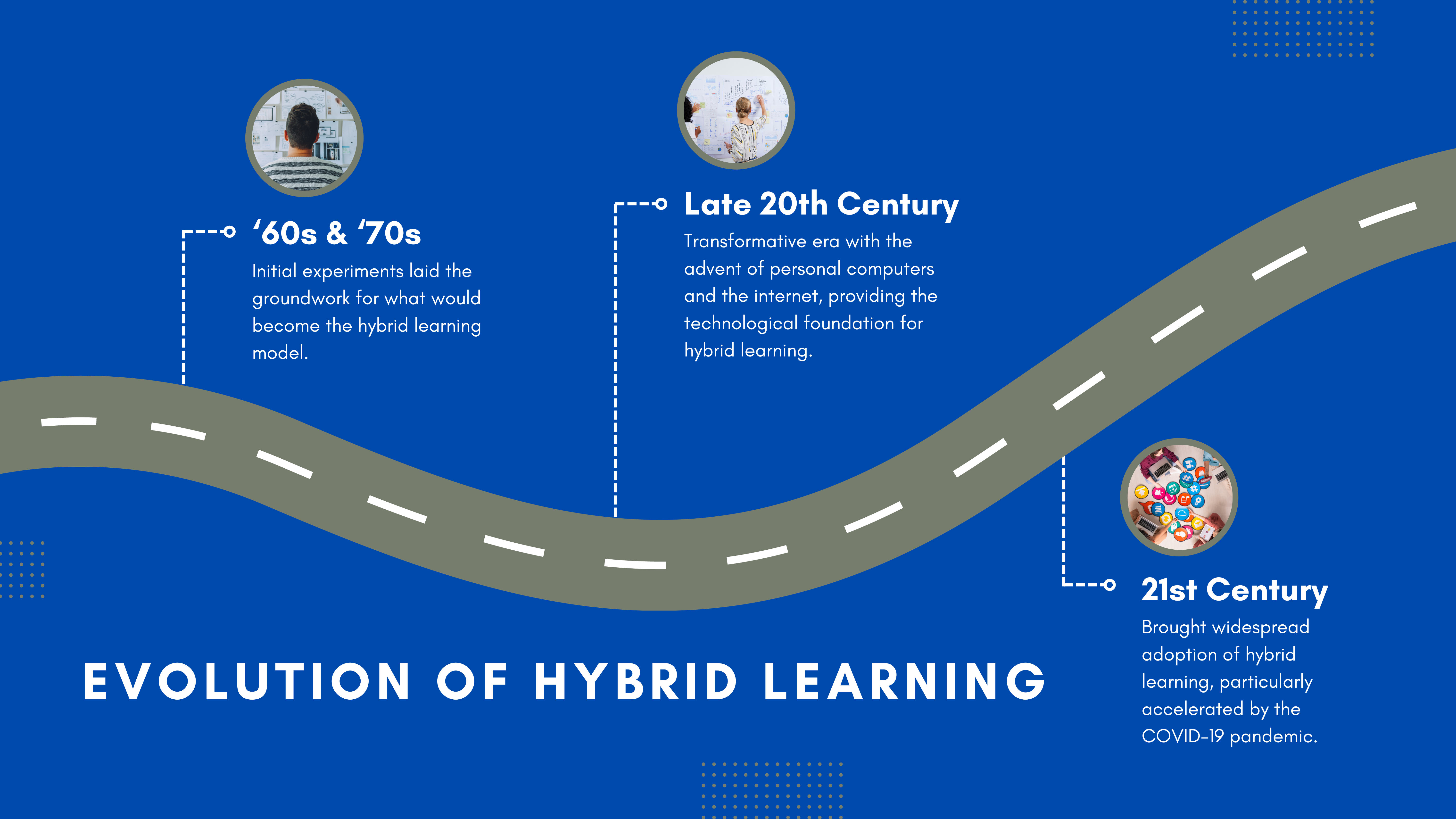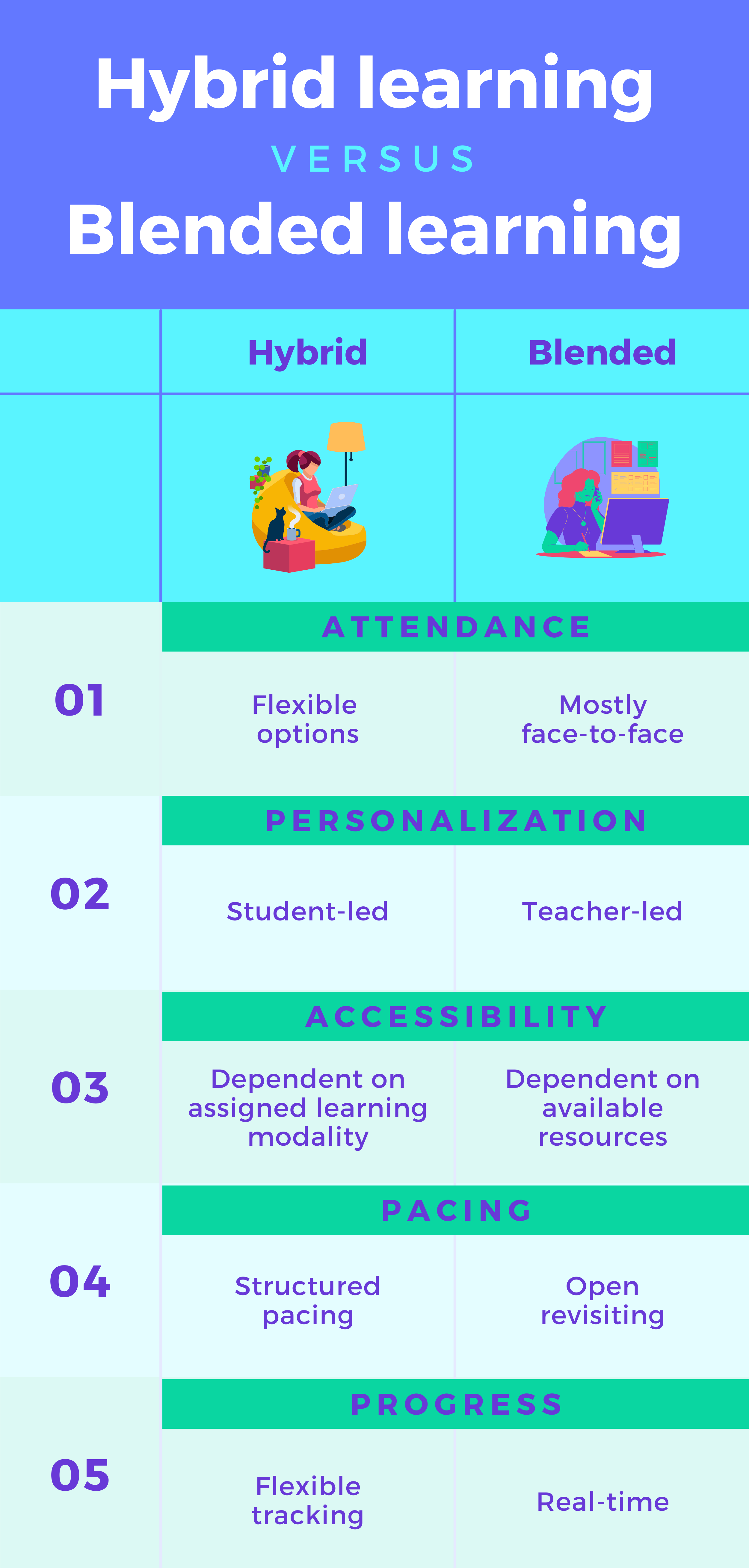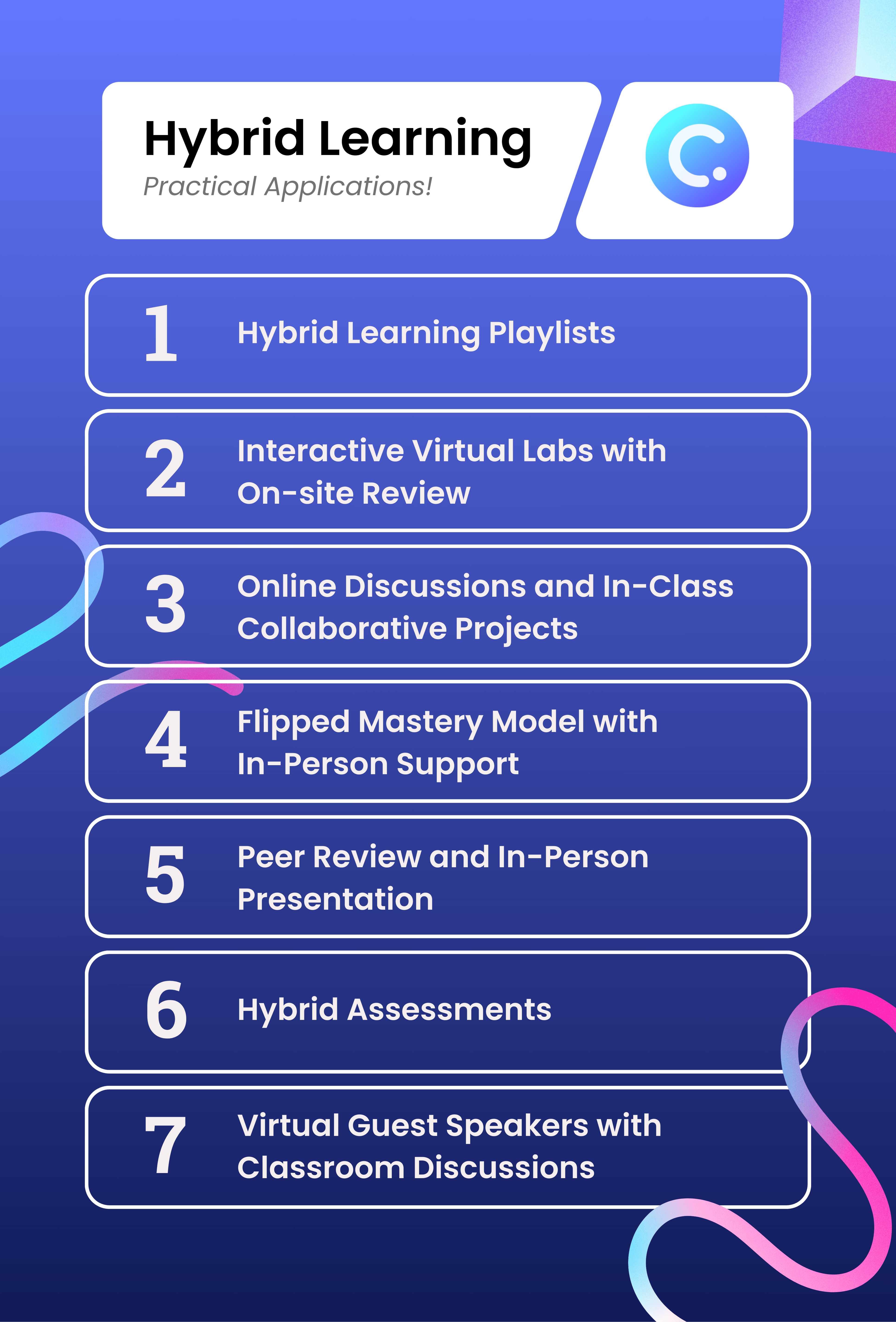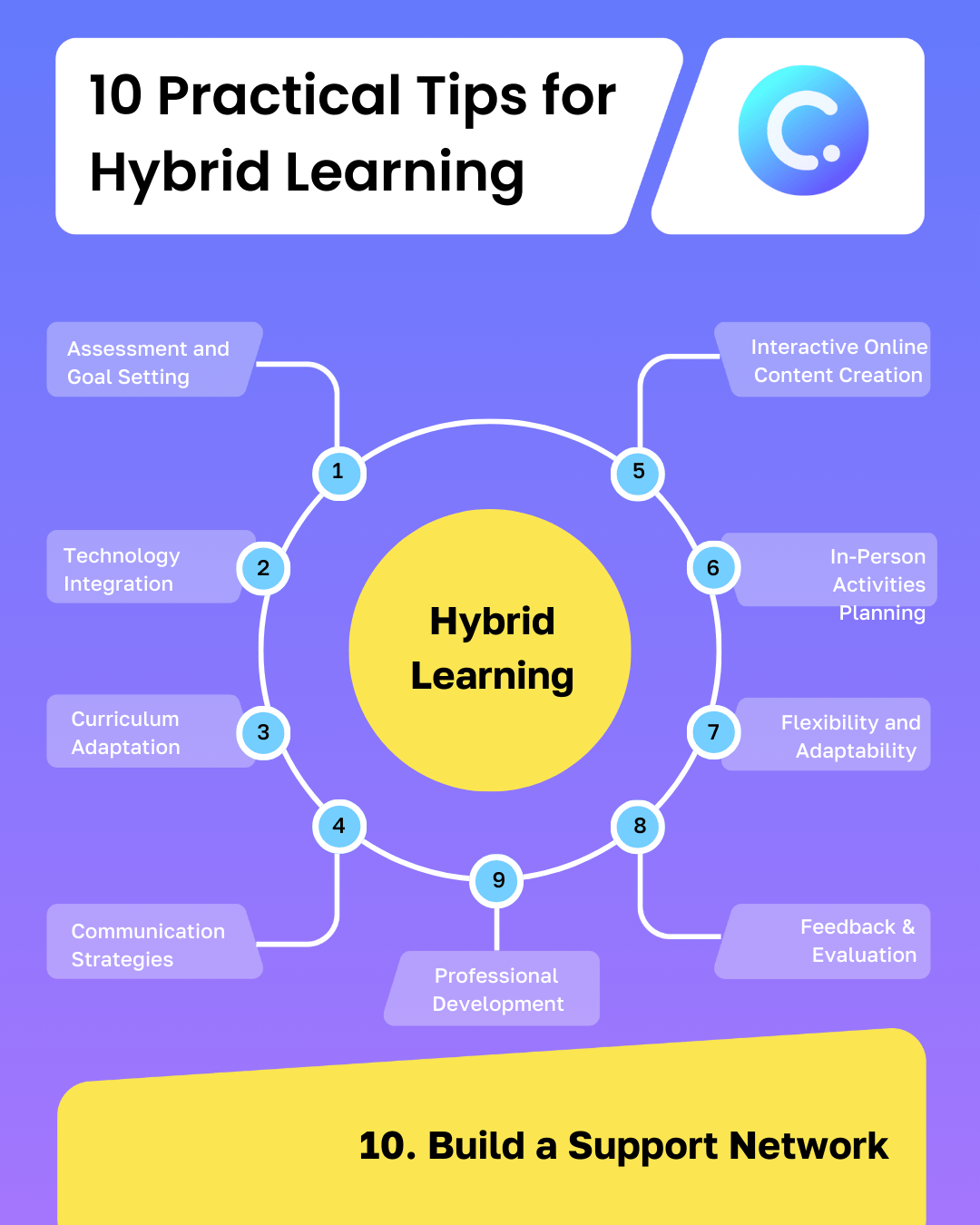Are you a teacher striving to find the perfect balance between old-school classrooms and modern digital learning? Do you wonder how to keep your students excited about education in this tech-driven age? If you’re nodding your head, you’re in the right place.
The evolving landscape of education has given rise to a powerful solution: hybrid learning. What exactly is hybrid learning, and how can it revolutionize your teaching methods? In an era where flexibility and adaptability have become essential traits for educators, this comprehensive guide is here to navigate you through the intricacies of hybrid learning. Stick around if you don’t want to miss out!
What is Hybrid Learning?
Hybrid learning is an innovative approach to education that seamlessly combines in-person and online learning components. It provides students with the flexibility to choose between attending physical classes and participating in virtual learning experiences. In a hybrid learning environment, students have the opportunity to access educational resources and engage in activities both in a traditional classroom setting and online.
Hybrid learning can offer varying degrees of flexibility and choice regarding physical or virtual attendance, depending on how it’s structured by the educational institution or instructor.
Some hybrid learning models provide students with the option to choose between physical or virtual attendance for specific classes or components of a course. In other cases, institutions may have a more structured approach, with certain components of the course delivered in-person and others online.
Key Features of Hybrid Learning
Hybrid learning comes packed with distinctive features that set it apart as a dynamic and effective educational approach.
- Flexibility in Learning Schedules
- Hybrid learning provides students with the flexibility to manage their learning schedules. With a blend of in-person and online components, students can access course materials and engage in activities at their own pace, accommodating various learning rhythms.
- Integration of Digital Tools and Resources
- One of the hallmarks of hybrid learning is the incorporation of digital tools and resources. From online textbooks and interactive modules to video lectures and collaborative platforms, technology like ClassPoint enhances the learning experience, making it more engaging and accessible.
With the many emerging EdTech tools in the market, there is one that stands out as the leading student engagement partner - ClassPoint. Seamlessly integrated into PowerPoint, ClassPoint lets you do interactive quizzing, dynamic presentations, and gamification without having to leave PowerPoint. A bonus feature: an AI quiz maker making quiz prep feel like a walk in the park!
- Personalized Learning Experiences
- Hybrid learning allows for personalized learning experiences. Through online assessments and analytics, educators can tailor instruction to meet individual student needs. This adaptability ensures that students receive the support they require while allowing high-achievers to explore advanced concepts.
- Enhanced Student-Teacher Interaction
- The hybrid model fosters a dynamic interaction between students and teachers, both in-person and online. Face-to-face classes provide traditional engagement, while virtual discussions and Q&A sessions contribute to a more robust and diverse learning experience.
Discourse in virtual discussions have been made easy by ClassPoint's Short Answer. With this activity type, teachers can send questions to students' devices which they can answer on the spot and submit back to your PowerPoint slide real-time.
- Adaptability to Diverse Learning Needs
- Recognizing that students have varied learning preferences, hybrid learning accommodates diverse needs. Whether students thrive in the collaborative environment of a physical classroom or prefer the autonomy of online learning, this model provides options to suit different learning styles.
Looking for ways to adapt your teaching to diverse learning needs? Check out 25 differentiated instruction strategies for modern classroom!
Historical Context of Hybrid Learning

The origins of hybrid learning can be traced back to mid-20th-century educational pioneers who sought innovative ways to merge traditional classroom instruction with emerging distance education approaches. Initial experiments in the 1960s and 1970s, featuring televised courses and correspondence materials, laid the groundwork for what would become the hybrid learning model.
The late 20th century marked a transformative era with the advent of personal computers and the internet, providing the technological foundation for a more seamless integration of in-person and online learning elements. As the internet became increasingly accessible, educational institutions explored its capabilities to enhance the learning experience.
The 21st century brought widespread adoption of hybrid learning, particularly accelerated by the COVID-19 pandemic. The global health crisis highlighted the importance of flexible learning options, and educational institutions rapidly embraced online tools and platforms to ensure continuity in education. This period underscored the resilience and adaptability of hybrid learning, shaping it into a crucial component of the modern educational landscape.
Hybrid Learning vs Blended Learning: A Side-by-Side Comparison
Hybrid learning and blended learning are terms often used interchangeably, but they encompass distinct educational models.
Clarifying the differences is crucial for a nuanced understanding of these approaches.

Hybrid learning, in its essence, integrates both in-person and online learning components, allowing students to engage with educational materials in traditional classrooms and through digital platforms. This model offers flexibility in attendance, providing a choice between physical and virtual participation for students.
Blended learning, on the other hand, typically involves the integration of traditional face-to-face instruction with online learning activities. In a Blended Learning model, the online component supplements and supports what is learned in the physical classroom, offering additional resources or alternative pathways for understanding.
While both hybrid learning and blended learning aim to combine traditional and digital instructional methods, the key distinction lies in the degree of liberty.
Hybrid learning often provides more choice for students to decide between physical and virtual participation, whereas blended learning emphasizes the complementary nature of online components to in-person instruction. Understanding this distinction is essential for educators and learners seeking to navigate the evolving landscape of modern education.
More on mastering blended learning here.
Comparative Analysis of their Benefits and Limitations
Navigating the nuances between hybrid learning and blended learning requires a comprehensive analysis of their respective advantages and challenges. Here’s a guide to help you:
✅ Benefits
| Benefits | Which Model Wins? | Why? |
|---|---|---|
| Flexibility and Accessibility | Hybrid Learning | Hybrid learning takes the lead in providing students with a unique blend of flexibility and accessibility. The model allows students to choose between attending in-person classes or engaging virtually, accommodating diverse schedules and preferences. |
| Personalized Learning | Hybrid Learning | The personalized learning experience in hybrid learning goes beyond adapting to individual pacing. It fosters tailored educational journeys by allowing students to explore digital resources, collaborate online, and engage in discussions during in-person sessions. |
| Increased Engagement | Hybrid Learning | Hybrid learning enhances student engagement through a dynamic combination of traditional and digital learning methods. In-person interactions provide the intimacy of face-to-face communication, while online elements introduce interactive technologies, simulations, and multimedia resources. |
| Combination of Learning Environments | Blended Learning | Blended learning excels in seamlessly integrating traditional and digital learning environments. It capitalizes on the strengths of face-to-face interactions for building relationships and understanding complex concepts, while also leveraging the benefits of online resources to enhance accessibility, allowing students to revisit materials at their own pace. |
| Enhanced Resources | Blended Learning | The incorporation of an online component in blended learning enriches the learning experience through a wealth of resources. From interactive simulations to multimedia presentations and collaborative platforms, this model provides an extensive toolkit for educators to deliver engaging and comprehensive lessons. |
❎ Limitations
| Limitations | Which Model is Susceptible? | Why? |
|---|---|---|
| Technology Dependency | Both models contend with challenges related to technology dependence. | Hybrid learning requires reliable internet access for virtual components, and blended learning relies on technology integration in traditional classrooms. |
| Logistical Challenges | Both models encounter logistical challenges that demand careful planning. | In hybrid learning, coordinating in-person and online components requires synchronization, while blended learning may face challenges in managing classroom technology, scheduling, and resource distribution. |
| Limited Flexibility in Attendance | Both models present limitations regarding flexibility in attendance. | Hybrid learning may face challenges when students need to shift between virtual and in-person attendance, and blended learning requires consistent in-person presence. |
| Infrastructure Requirements | Both models face challenges related to infrastructure requirements. | Hybrid learning demands access to technology for both educators and students, while blended learning necessitates technology-equipped classrooms and reliable internet connectivity. |
Get Inspired by These 7 Practical Applications of Hybrid Learning

Hybrid learning finds practical application in classrooms through various models that seamlessly blend in-person and online components:
- Hybrid Learning Playlists
- What it is: Hybrid Learning Playlists are dynamic blends of online lectures, interactive modules, and in-person activities curated to individualize the learning experience. It’s like a customized playlist, guiding students through digital and hands-on exploration.
- How you can implement it: Develop a curated playlist of online resources, assigning these materials for independent study. Use in-person class time for group discussions, clarification of doubts, and hands-on activities related to the playlist topics.
Pro Tip: Create your playlist within a PowerPoint slide and directly send it to your students' phones with ClassPoint's Share PDF.
- Interactive Virtual Labs with On-site Review
- What it is: Interactive Virtual Labs with On-site Review bring experimentation beyond physical boundaries. Students explore virtually, and in the classroom. They review, discuss findings, and conduct hands-on experiments, blending online inquiry with tangible discovery.
- How you can implement it: Provide access to virtual labs for pre-class exploration. In class, review lab results, discuss findings, and conduct hands-on experiments, reinforcing theoretical knowledge with practical application.
- Online Discussions and In-Class Collaborative Projects
- What it is: Online Discussions and In-Class Collaborative Projects create a seamless transition from virtual dialogues to tangible projects. Students converse online, and in the classroom, these discussions evolve into collaborative projects, merging digital and physical realms.
- How you can implement it: Initiate online discussions on a designated platform for independent exploration. Transition to collaborative in-person projects during class time, allowing students to apply insights, refine ideas, and work together on activities related to the discussed topics.
Pro Tip: Online discussions are more fun with a little bit of thrill. Keep students on their toes with ClassPoint's Name Picker. Spin a wheel of names, pick from a deck of emoji cards, or group students in one bulk all inside PowerPoint.
- Flipped Classroom with In-Person Support
- What it is: Flipped classroom empowers students to navigate their learning journey. Online modules invite exploration, and in-person sessions provide personalized support, addressing individual queries, and fostering collaboration.
- How you can implement it: Provide pre-recorded lectures and materials for self-paced learning outside of class. In-person sessions focus on addressing individual queries, offering personalized support, and engaging students in collaborative projects or discussions reinforcing the mastered content.
Pro Tip: Share pre-lesson materials with students using ClassPoint's SharePDF and run a pre-lesson quiz with these 8 interactive quiz types to prime students with the teaching materials before class.
- Peer Review and In-Person Presentation
- What it is: Peer Review and In-Person Presentation shape assignments collaboratively. Online critique refines the work, and in-person class time becomes the platform for students to showcase their creations, fostering collaborative growth.
- How you can implement it: Implement an online peer review system for assignments. In-person sessions can be utilized for students to incorporate feedback, rehearse presentations, and deliver them to the class, encouraging constructive discussions and further refinement.
- Hybrid Assessments
- What it is: Hybrid Assessments blend online quizzes for theoretical understanding with in-person evaluations for practical application, providing a comprehensive measurement of student understanding.
- How you can implement it: Design assessments that include online quizzes and in-person evaluations. Use online platforms for submission and grading of theoretical assessments, while in-person sessions facilitate hands-on evaluations and critical thinking exercises.
Try ClassPoint AI to generate instant quiz based on your PowerPoint slide content!
- Virtual Guest Speakers with Classroom Discussions
- What it is: This model involves inviting virtual guest speakers for presentations or interviews, followed by in-person class time dedicated to facilitated discussions, Q&A sessions, and collaborative activities that delve deeper into the topics presented virtually.
- How you can implement it: Invite guest speakers for virtual presentations. In-person class time can be allocated for facilitated discussions, Q&A sessions, and collaborative activities that foster interactive and engaging conversations related to the topics presented virtually.
Pro Tip: Conduct a Quick Poll to check understanding after the guest speaker presentation.
Key Importance of Hybrid Learning
Benefits for Teachers
Hybrid learning revolutionizes the teaching landscape, offering educators a dynamic blend of online tools and in-person interactions. This multifaceted approach not only caters to diverse learning styles but also empowers teachers in various ways.
📈 Streamlined Instruction
- Streamlined Instruction in hybrid learning enables teachers to deliver content through a combination of online and in-person methods. This approach enhances accessibility and engagement, accommodating the preferences of a diverse student body.
💬 Personalized Feedback
- Personalized feedback becomes more accessible with the hybrid model. Teachers can leverage online platforms to assess individual progress, provide targeted feedback, and tailor their guidance to address specific learning needs.
⚒️ Enhanced Resource Utilization
- Enhanced resource utilization allows educators to optimize the use of resources by integrating multimedia content, interactive simulations, and digital tools. This enriches the overall learning experience and fosters a more dynamic classroom environment.
⏳ Time Efficiency
- Time efficiency is a key advantage for teachers in hybrid learning. By creating and sharing online materials outside of class, educators can maximize in-person time for interactive discussions, activities, and addressing individual student requirements.
Benefits for Students
Hybrid learning goes far more than just a concept; it’s a transformative educational approach that empowers students with flexibility, personalized learning, and real-world application. Here’s a closer look at how students reap the rewards of this innovative model.
💪🏻 Flexibility and Autonomy
- Flexibility and autonomy are at the core of hybrid learning for students. The model allows them to access online materials at their own pace, offering the flexibility to review content and engage in in-person activities according to their individual preferences.
🚥 Individualized Learning Paths
- Individualized learning paths become possible through the hybrid model. Students can focus on specific areas that require more attention, progressing at their own pace with online resources tailored to their learning needs.
🌍 Real-world Application
- Real-world application is a distinctive benefit. Hybrid learning encourages students to apply their knowledge in practical scenarios, fostering critical thinking skills and reinforcing theoretical concepts through hands-on experiences.
🥳 Improved Engagement
- Improved engagement is a hallmark of hybrid learning. The combination of interactive online modules and in-person activities captures students’ attention, providing a well-rounded and engaging educational experience.
10 Practical Tips for Teachers Considering Hybrid Learning
Embarking on the journey of hybrid learning requires thoughtful planning and strategic implementation. Hybrid learning thrives on adaptability, so educators should be prepared to iterate and refine their approach based on ongoing feedback and evolving circumstances.

For a successful transition to a hybrid learning model, consider these tips:
- Assessment and Goal Setting
- Begin by assessing the specific needs and learning styles of your students. Set clear goals for the integration of online and in-person elements, aligning them with your overall curriculum objectives.
- Technology Integration
- Familiarize yourself with the technology tools and platforms suitable for hybrid learning. Ensure that both you and your students are comfortable navigating these tools to facilitate a smooth online experience.
- Curriculum Adaptation
- Adapt your curriculum to the hybrid model, identifying areas suitable for online engagement and those best addressed in-person. Create a balance that maximizes the benefits of both approaches.
- Communication Strategies
- Establish clear communication channels with students. Clearly outline expectations, schedules, and how online and in-person components will complement each other. Foster a transparent environment to address any concerns or queries promptly.
- Interactive Online Content Creation
- Develop interactive and engaging online content. Leverage multimedia resources, discussion forums, and virtual activities to enhance the online learning experience and keep students actively involved.
- In-Person Activities Planning
- Plan in-person activities that capitalize on face-to-face interaction. These activities should complement online learning, providing opportunities for collaboration, hands-on experiences, and deeper discussions.
- Flexibility and Adaptability
- Embrace flexibility and adaptability as core principles. Hybrid learning requires the ability to adjust strategies based on student feedback, technological challenges, and unforeseen circumstances.
- Feedback and Evaluation Mechanisms
- Establish regular feedback mechanisms for both online and in-person components. Use assessments, surveys, and open communication channels to gather insights and refine your teaching approach continuously.
- Professional Development
- Invest time in professional development to stay updated on educational technology trends, teaching methodologies, and effective strategies for hybrid instruction. Continuous learning is key to a successful transition.
- Support Networks
- Build a support network with fellow educators and administrators. Collaborate, share experiences, and seek guidance to navigate challenges and celebrate successes in the evolving landscape of hybrid teaching.
Successfully transitioning to hybrid learning involves a thoughtful blend of pedagogical expertise, technological proficiency, and a student-centric approach. By following these steps, you can create a dynamic and effective hybrid teaching environment that enhances the overall learning experience.
Final Thoughts
In the ever-modernizing world of education, hybrid learning stands out. It’s not just about overcoming challenges; it’s a peek into the future of how students learn. Seeing how it benefits both teachers and students, it’s clear that hybrid learning isn’t just another passing trend but rather, a ray of light shaping the future. With its blend of digital tools and face-to-face experiences, it’s becoming a foundation for a more flexible, accessible, and innovative approach to learning.
In a world where change is constant, it’s a steady guide, making education more tailored and responsive. As tech keeps evolving, so does the role of hybrid learning, ensuring that education remains a lively and fulfilling journey for everyone involved. Keep in mind that the EdTech market is an active hub of new technological discoveries, so stay on the lookout for tools that would work best for you. Good thing, the #1 hybrid learning tool in PowerPoint is free to sign up for!
